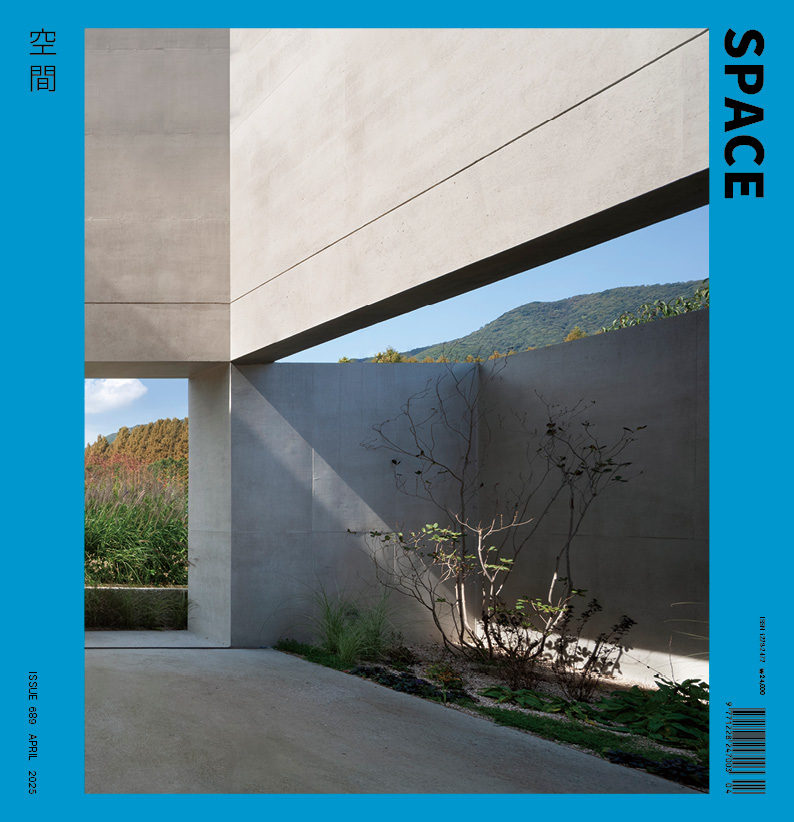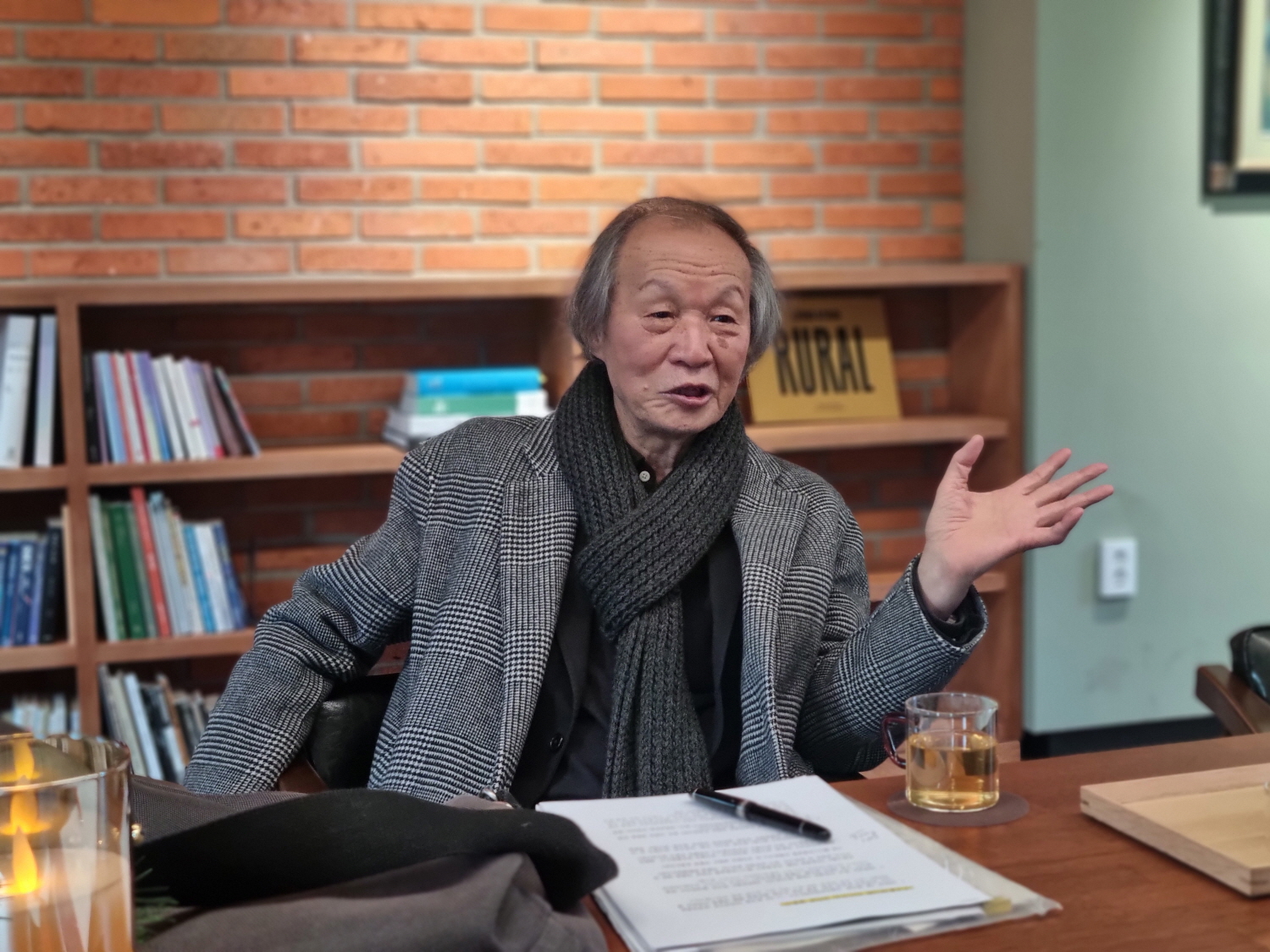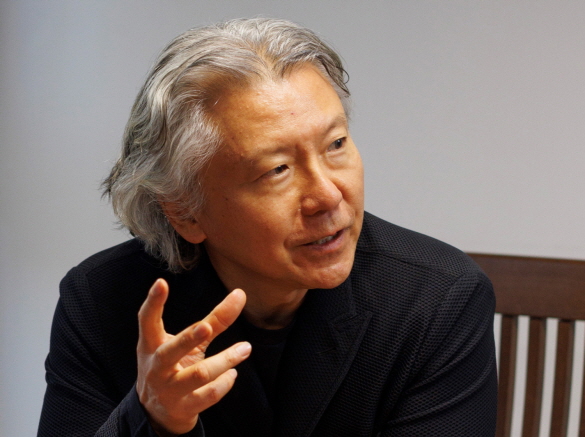SPACE April 2025 (No. 689)
SPACE is preparing an archival book, Archiving International Architecture Exhibition at the Korean Pavilion at the Venice Biennale 1996 – 2025 (tentative title), as part of the ‘30th Anniversary Archival Research of the Korean Pavilion at the Venice Biennale’, organised by the Arts Council Korea (ARKO). The archive book, scheduled to be published in May 2025, will include interviews with the commissioners of the early exhibitions at the Korean Pavilion, and will be published in a series of SPACE. Through these interviews, SPACE will reconstruct a narrative of the early years of Korean architecture exhibition history centred on the Venice Biennale and reflect on the meaning of the Korean Pavilion as it celebrates its 30th anniversary.
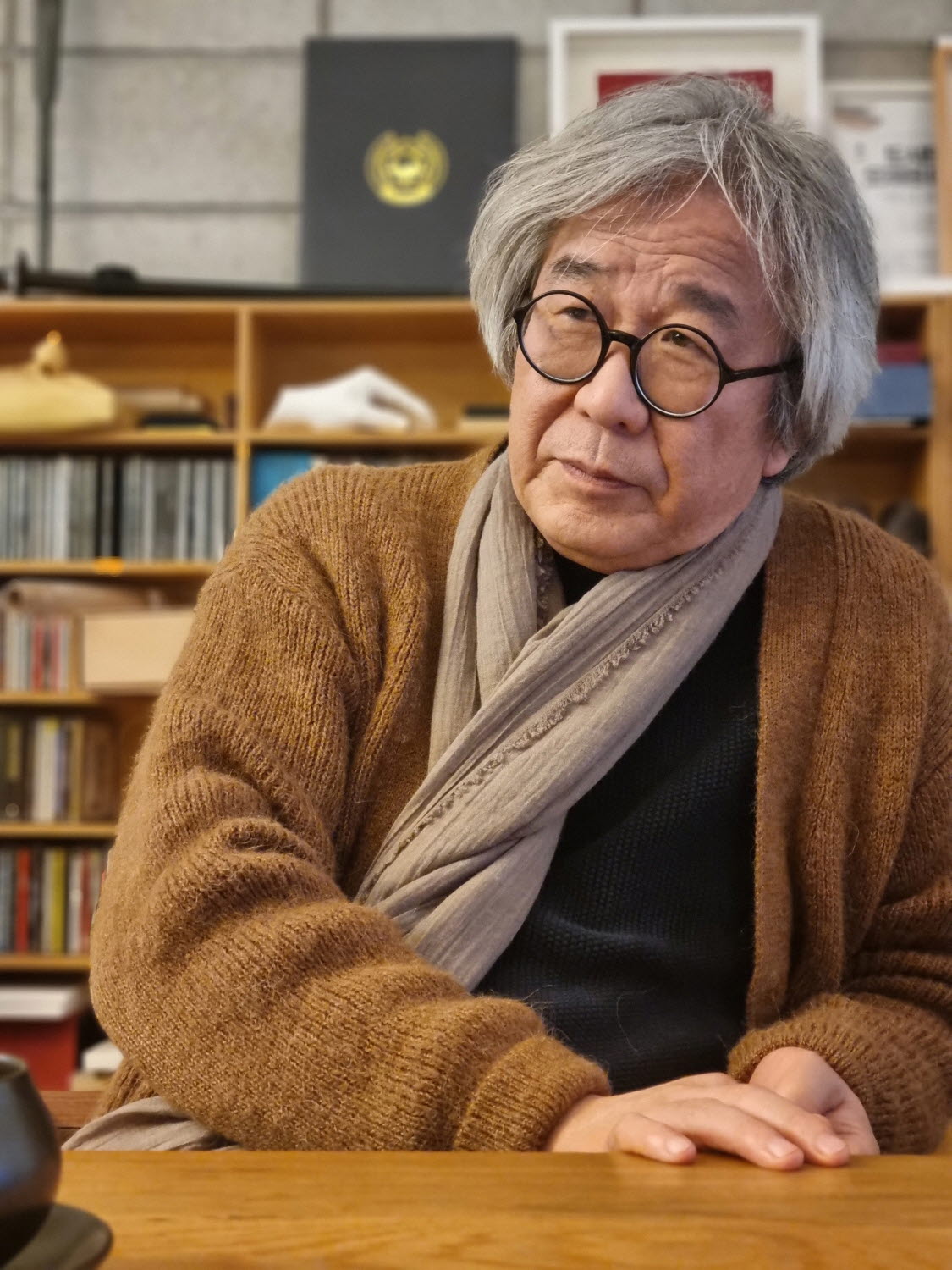
Seung H-Sang, being interviewed in the IROJE architects & planners on the 26th of December, 2024 ©Bang Yukyung
Seung H-Sang, Commissioner of the Korean Pavilion at the 11th International Architecture Exhibition of the Venice Biennale 2008
The sixth commissioner of the Korean Pavilion at the International Architecture Exhibition of the Venice Biennale (hereinafter Architecture Exhibition) was Seung H-Sang. Having spent 15 years under Kim Swoo Geun at SPACE Group of Korea, he established his own office, IROJE architects & planners in 1989. He has since pursued a diverse architectural career, including activities with the 4.3 Group and participation in founding the Seoul School of Architecture (sa). In 1996, Seung H-Sang published and held exhibitions on the theme of the ‘Beauty of Poverty’, and, in 2002, he became the first architect to receive the ‘Artist of the Year’ award, National Museum of Modern and Contemporary Art, Korea, solidifying his position as a leading architect representing Korea. Houses such as Sujoldang (1992) and Subaekdang (1999), as well as urban architectural projects like Welcomm City (2000), which materialised the ‘publicness’ of urban architecture through the concept of the ‘Urban Void’, and the Paju Bookcity project, which expanded this concept to an urban scale, were introduced in his large-scale retrospective exhibition in celebration of this award, and they have become his representative masterpieces. Starting in 2000, Seung H-Sang began to expand his activities internationally, participating in various architectural exhibitions, including the Venice Biennale. He was invited as a guest artist for the main exhibition in 2000, to exhibit in the Chinese Pavilion and Japanese Pavilion in 2002, and later appointed as the commissioner for the Korean Pavilion in 2008. Building on his previous experience at the Architecture Exhibition, Seung H-Sang assembled an exhibition team centred on documenters and curators, and presented a new perspective on architecture by surveying the entire process of creating Paju Bookcity, a collaborative project involving various stakeholders. This exhibition was in response to the theme ‘Out There: Architecture Beyond Building’, proposed by the director, Aaron Betsky. In an interview with SPACE in December of last year, he reflected specifically on his experiences as both an artist and commissioner at the Architecture Exhibition, discussing the influence of the Venice Biennale on his architectural philosophy, as well as the role of the Korean Pavilion as an international platform to showcase Korea’s talents to the world.
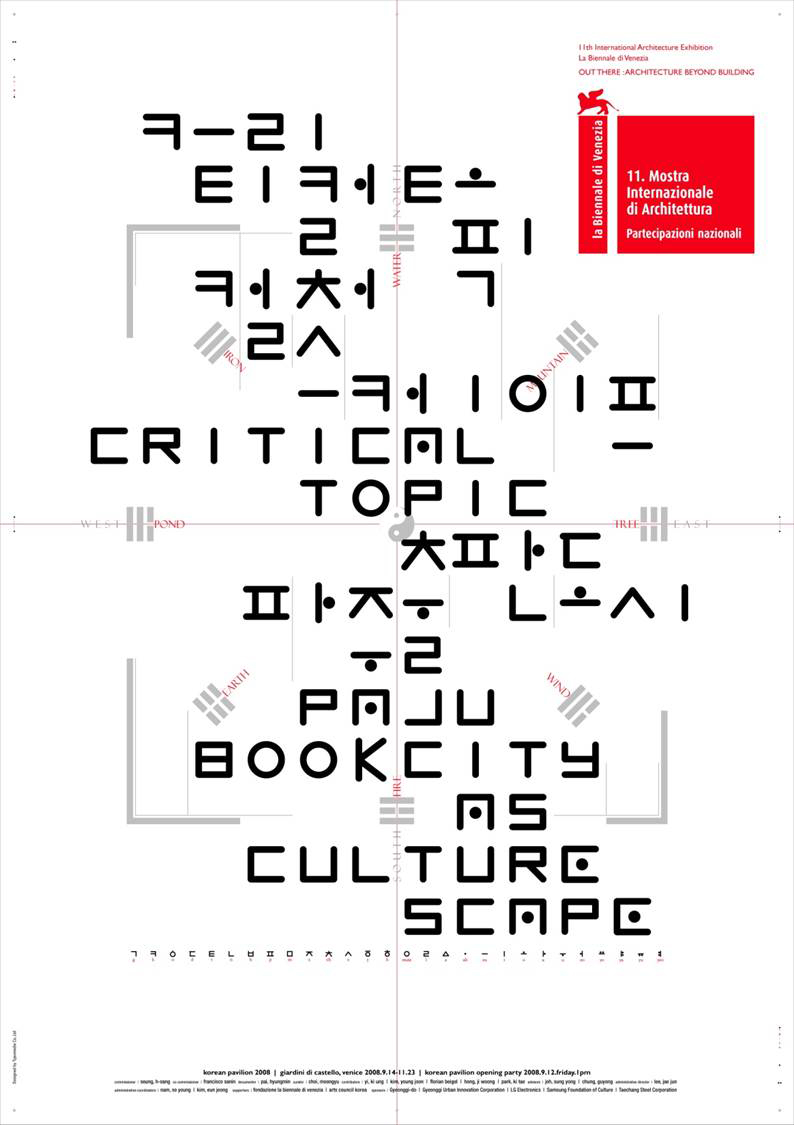
The poster of the Korean Pavilion at the 11th International Architecture Exhibition of the Venice Biennale 2008 / Image courtesy of Pai Hyungmin / ©Hong Dongwon
Experiences at the Venice Biennale in 2000 and 2002
Bang Yukyung: On the 13th of February, 2008, you were appointed as the commissioner for the Korean Pavilion at the International Architectural Exhibition of the Venice Biennale 2008. How do you remember the moment when you received the final selection news?
Seung H-Sang: The year 2008 is 16 years ago, so it’s been quite a while! I don’t know much about the selection process itself. However, I heard that the initial nominee was Min Hyunsik. Since he declined the position, they reached out to me instead. (laugh) Just before that, Chung Guyon and Joh Sungyong had served as commissioners. At the time, I had a vague sense that I would take on the role at some point.
Bang Yukyung: You had previously participated in the Venice Biennale as an invited architect before 2008, twice, in the main exhibition in 2000 and the Japanese Pavilion exhibition in 2002.
Seung H-Sang: Yes, that’s right. The director in 2000 was Massimiliano Fuksas, and the theme he proposed was truly remarkable: ‘Cities: Less Aesthetics, More Ethics’. This phrase, which quotes David Harvey, is something I still frequently reference today. It was inspiring to see that architecture in the West, which had traditionally focused on aesthetics, was calling for a shift towards more ethical considerations in the twenty-first century. To be honest, before that, I had only been vaguely aware of the Venice Biennale’s existence and wasn’t familiar with its exhibition content. When I was first invited, I thought it would be fitting to present a project with strong public values, in line with the theme of ‘ethical architecture’, rather than a conventional architectural work, and that’s why I submitted the project, Paju Bookcity. Since I was unfamiliar with the submission format, I used a rather old-fashioned approach—drawings, models, and panels. The organisers gave me a decent exhibition space, but my work didn’t attract much attention. (laugh) The exhibition theme was so fascinating that I visited all of the exhibited works, but I was quite disappointed to see that most architects simply showcased their own projects without truly engaging with the ethical demands of architecture. That was when I realised that many participants didn’t take the exhibition themes very seriously. At the time, Kim Seok Chul was the commissioner of the Korean Pavilion, but I wasn’t particularly fond of the exhibition, and I spoke my mind to him. From that moment on, I started thinking that ‘the exhibition at the Venice Biennale shouldn’t be like this’. Still, the theme of the 2000 had a significant impact on my architectural career.
Bang Yukyung: How would you describe the process when you participated as an invited architect for the Japanese Pavilion in 2002?
Seung H-Sang: At that time, Isozaki Arata was the commissioner of the Japanese Pavilion, curating the exhibition under the theme ‘Asian Characters: The Creation of Architectural Languages in Regions where KANJI are Used’, and he invited me to be one of the featured architects. The exhibition was based on the notion of defining Asia’s characteristics through the lens of the ‘Kanji cultural sphere’ and showcasing architecture from regions within that sphere. Architects from four regions – Korea, China, Japan, and Vietnam – were selected, and we had a preliminary discussion about which works to exhibit. Since the theme focused on the Kanji cultural sphere, the use of Chinese characters was a key aspect. I presented Sujoldang and Subaekdang, projects in which I had incorporated Chinese characters, and proposed exhibiting the process behind their creation. For my exhibition space, I covered the floor with traditional Korean floorcovering sheets, and applied hanji (traditional Korean paper) wallpaper printed with explanatory text and design details. Of course, I also included architectural models. Since the exhibition emphasised language, I wanted to express the more conceptual aspects of language through these display techniques. I found the other three participating architects took completely different approaches. One architect explained that growing up within the Kanji cultural sphere had influenced his entire way of thinking and working, and he displayed a large model of a building he had designed. Once again, I found myself thinking, ‘I’m the only one who took the theme so literally’. (laugh) Isozaki himself, as the commissioner, did not interfere much with the display of the individual projects—he just listened to my plans and expressed his approval.
Bang Yukyung: Up until that point, the Korean Pavilion at the International Architectural Exhibition had rarely invited foreign architects. In contrast, Japanese Pavilion’s approach of showcasing architects from across Asia seems to reflect a different perspective and curatorial focus.
Seung H-Sang: That’s something that left me with mixed feelings. I felt a sense of pride in being invited as a representative Korean architect to the Japanese Pavilion, but I couldn’t help but wonder whether this was an extension of Japan’s imperialist mindset—an assertion that it still maintained dominance over Asia. Regardless, in the following year, the rapport with Isozaki Arata led to the exhibition at Gallery MA in Tokyo, which was established by the TOTO Group and had gained international recognition by hosting exhibitions of renowned architects. In 2004, the gallery organised a duo exhibition▼1 featuring myself and Chinese architect Chang Yung Ho. This opened doors for me to exhibit in various international venues thereafter.
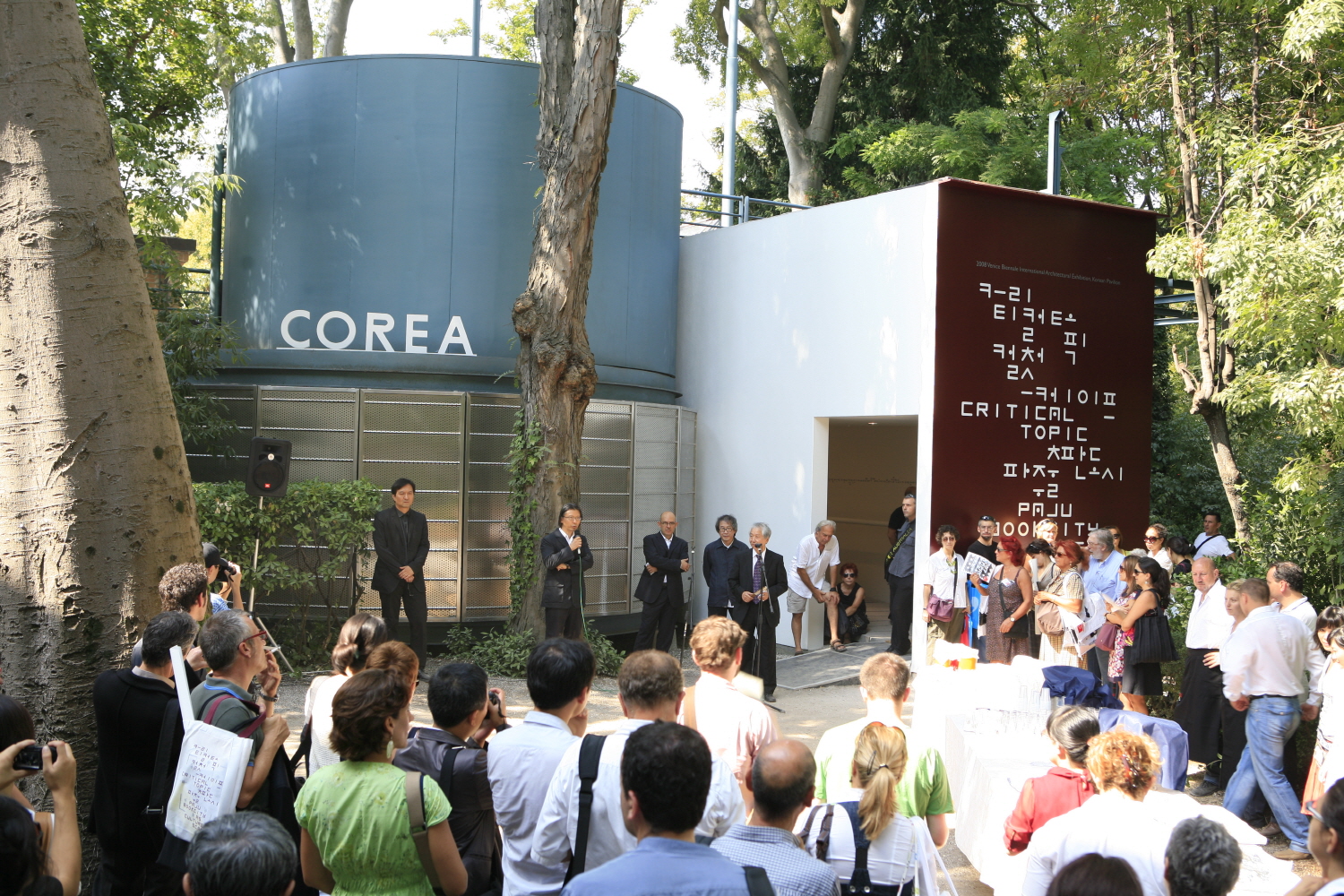
The opening ceremony for the Korean Pavilion at the 11th International Architecture Exhibition of the Venice Biennale 2008 ©Kim Jongoh
From Artist to Commissioner
Bang Yukyung: Considering your participation in the 2000 main exhibition, the Japanese Pavilion, and in international exhibitions, it seems like you had a deeper understanding of the role of a commissioner compared to others.
Seung H-Sang: Through these experiences, I had gained insight and long considered how I would approach the role if I ever became the commissioner of the Korean Pavilion. So, when Arts Council Korea (ARKO) asked me to take on the role in 2008, I accepted without hesitation. A commissioner is essentially someone who delivers missions to participants. The commissioner must clearly define the theme, form the necessary team accordingly, and select the artists. Of course, I also needed to assign clear missions to the artists and take responsibility for ensuring that the exhibition aligned with these missions. On the other hand, as an artist, I only needed to think about best how to convey my vision of architecture, which is a completely different matter.
Bang Yukyung: It seems you made a clear distinction between the areas in which a commissioner should intervene and where he should not.
Seung H-Sang: I tend to immerse myself in given assignments. Once the overarching theme of the Venice Biennale is determined, the ideas should stem from that theme. I believe the commissioner’s role is to assess whether the exhibition aligns with the theme all the way throughout the process. However, after participating several times, I realised that commissioners from other countries did not always perform this supervisory role. As I mentioned earlier, most participants exhibited whatever they wanted regardless of the theme, and this was widely accepted. Seeing this, I sometimes wondered, ‘Am I the only fool? Am I the only one strictly adhering to the theme?’ (laugh)
Bang Yukyung: When you were selected as the commissioner in 2008, how did you interpret the theme set by the director, Aaron Betsky, and what did you decide to bring to attention in the Korean Pavilion?
Seung H-Sang: The theme that year was ‘Out There: Architecture Beyond Building’. It was an excellent theme that posed a fundamental question: what is architecture beyond buildings? A good question often contains its answer. In an article by Aaron Betsky, he stated that ‘architecture should not become the tombs of buildings.’ To me, this meant that architecture should be viewed not as a physical entity, not as real estate, but as the social and cultural phenomena occurring within and around a structure. This concept aligned perfectly with the message of Paju Bookcity. Just like the phrase ‘Out There’ suggests looking beyond, I thought it was fitting to showcase what lay beyond. Thus, we adopted ‘Here is Paju Bookcity’ as the slogan for the Korean Pavilion. In response to the question of what lies beyond, we answered, ‘Here lies Paju Bookcity.’ Physically, Paju Bookcity is a collection of buildings forming a city, but it was not just built by architects—it emerged through the participation of workers, residents, programmes and the dynamic forces of its era. It was the perfect subject to explore the question of ‘who truly creates architecture and cities’.
Bang Yukyung: When you first introduced Paju Bookcity in the theme exhibition in 2000, the project was still in its early stages, was it not?
Seung H-Sang: Yes, it was at the beginning stages of construction, so we exhibited only models, some drawings, and photographs—a physical representation of its landscape. We also provided a general introduction to the design guidelines (so-called Great Contract), which had been declared by architects and clients to create an ethical city. In 2008, however, we sought to deconstruct and explain each element in detail. While the 2000 exhibition focused on the external appearance of Paju Bookcity, the 2008 exhibition delved into the fundamental issues underpinning its formation. This approach naturally led to selecting participants who were not just architects in the traditional sense but those who actively contributed to the city making—publishers, leaders of publishing associations, company executives who became clients, and cultural activists who supported the movement. I wanted to bring them into the exhibition as featured artists.
Bang Yukyung: By 2008, the city had taken shape to some extent, making interviews with participants possible.
Seung H-Sang: Absolutely. Dozens of buildings had been constructed by then. (...)
_
1 Hosted by Korea Culture and Arts Foundation (currently Arts Council Korea), ‘East Asian Architecture: Beyond the Border’, duo exhibition featuring Seung H-Sang and Chang Yung Ho was held at Gallery MA in Tokyo from 28 Feb. to 1 May 2004. Source: https://jp.toto.com/gallerma/ex040228/index.htm [accessed 17 Feb. 2025]
